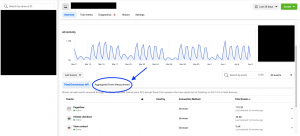
PARKER KUMP
With so many marketing avenues to choose from, it may be hard to choose which should be your top priority. In today’s digitally-connected world, paid advertising remains the most consistent and reliable way of growing your business.
Most brands invest advertising dollars into Facebook/Instagram Ads and Google Ads to achieve scalable results. Yet, it’s not without its difficulties.
With social and search platforms, it has never been more expensive or more difficult to see big wins. There’s no doubt the data loss caused by Apple’s recent iOS14.5 update has been felt by every marketer in some way or another.
That leaves us with one big question, should businesses invest not only money and resources, but also time into these channels? The answer is absolutely.
But, the days of just slapping together a graphic to throw in a Facebook ad or putting your budget towards maximizing clicks and expecting results on Google are long over.
Campaigns have to be structured by intent. So, here are 6 simple but mighty steps every business can take to substantially increase their chance of success in paid advertising.
Facebook/Instagram Ads
- Pixel installed with Aggregated Events
When it comes to understanding your audiences, data is your best friend!
Installing a pixel allows Facebook to learn every aspect of your highest converting customers. Yes, IOS 14+ has affected the reporting however by using aggregate events and a properly installed pixel the platform still maximises its artificial intelligence. But, what happens after you set up ad campaigns? What good are pixels?
Pixels become even more valuable. Custom audiences and lookalike audiences can be built based on pixel data to better target high-value customers and influence their purchase decisions. Additionally brands can start depending on the pixel to accurately target potential audiences by just leveraging their data. By then finalising your set up with aggregate events tells the platforms exactly which conversions you care the most about.

- Invest in creatives and copy
Before you invest money into creatives, think about the purpose of your campaign. But most importantly, look into what your competition is doing. Don’t be afraid to do a little snooping. The Facebook ads library is our best friend and it can be yours too.
UGC and Facebook ads might just be a match made in heaven. Intriguing text that beckons customers to click, unique eye-catching high-quality images or video, a bold call to action and moving your audience to the appropriate landing page will do the job. It’s a fact.
Remarketing is undeniably effective. It enables you to show ads to a perfectly primed audience-people who have already visited your site-and nurture them into converting or returning for more.
Rather than simply reusing eye-catching image ads with zero value, go the extra mile to craft creative ads to connect specifically with your retargeting audience.
- Test test test
Often when marketers say that Facebook ads don’t work, they just haven’t tested enough variables or the right variables to determine what’s working and what’s not. Many people change too many things all at once or forget to make the one adjustment that could have the greatest impact on their results. When it comes to testing Facebook ads, it helps to both be strategic and systematic.
Your budget will determine how many audiences and variables you can test. Make sure to compare cold audiences either lookalike audiences, interest based or open audiences to warmer retargeting audiences within Facebook to test your campaign.
Few examples of campaigns to test out:
– Lookalike audience (based off Facebook, Instagram, and website data)
– Groups of similar interests in ad sets
– Single interest ad sets
– Warm retargeting campaigns (anybody that has engaged but not purchased with social or website)
Google Ads
- Track & Use Conversions Properly
Do not spend money on Google Ads without tracking the Conversions that have value for you- whether form leads, sales, chats or phone calls. Hire someone to help you figure this out in the beginning, or hire an agency if you wish to waste even less money! But without Conversions, you will be flying blind and unable to see the winners and losers in your campaigns, which is important to scale and improve your traffic quality. Pro tip: If you track multiple Conversions with staggered values, you must use Manual or a value-considered bid strategy, like Maximize Conversion Value or Target ROAS. Whereas Maximize Conversions will simply “value” or treat all of your Conversions the same and ignore your staggered values.
- Stay On Top Of Your Competitors
An often overlooked area in Google Ads is “Auction Insights”. Find it and see who you’re up against! Google shares the URLs of competitors who are actively advertising in the same market or on the same keywords as you. Check out their websites and keep an ongoing list of your major competitors. Try to see their offer and presence, compared to yours, through your mutual customers’ eyes and live Google searches. Check this monthly, or every few months, and you will be shocked by the ideas and leverage this “habit” can generate for your own business planning and growth.
- Segment Your Clicks By Click Type
“Not all clicks are created equal”. Use the SEGMENT button in your Google Ads interface, to see the breakdown of your “Clicks” by “Click Type”. You should see mostly Headline/Sitelink clicks in Search campaigns, but if you are spending any money on click interactions with your Location Extension, you will see clicks on Driving Directions or related terms.
Google will always encourage you to link your Google My Business Location, and benefits include your ad showing up in Google Maps placements. However, if you are NOT a “storefront business” wanting customers to visit your location, you may be wasting money on these clicks! So if that’s the case, you will want to turn your Location Extension OFF at the Campaign Level. Further, Google offers a special campaign type for storefront businesses called “Local Campaigns” and you are better off keeping your storefront strategy siloed off from your Conversion-focused campaigns.
If you’re a business owner and want to learn more in depth strategies get in touch with the team over at Tuff Media so they can book a strategy call with you today!


